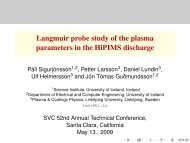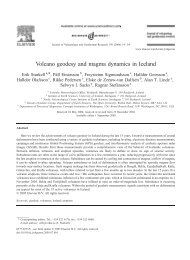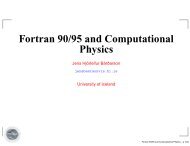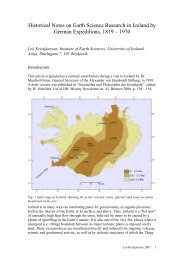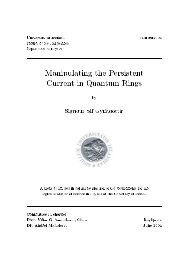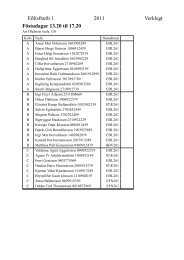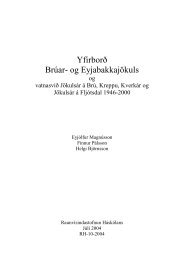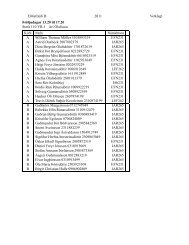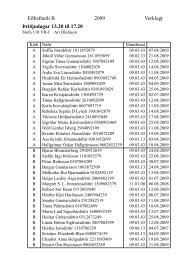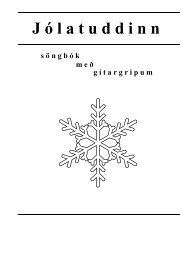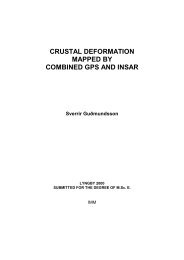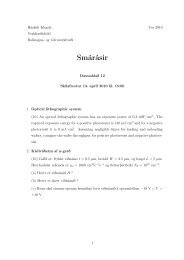Approximating Maximum Independent Sets by Excluding Subgraphs 1
Approximating Maximum Independent Sets by Excluding Subgraphs 1
Approximating Maximum Independent Sets by Excluding Subgraphs 1
You also want an ePaper? Increase the reach of your titles
YUMPU automatically turns print PDFs into web optimized ePapers that Google loves.
As appearing in BIT 32, 2, June 1992.<strong>Approximating</strong> <strong>Maximum</strong> <strong>Independent</strong> <strong>Sets</strong> <strong>by</strong><strong>Excluding</strong> <strong>Subgraphs</strong> 1Ravi Boppana 2 and Magnus M. Halldorsson 3Department of Computer ScienceSchool of Information ScienceNew York UniversityJapan Advanced Institute of ScienceNew York, NY 10012and Technology, HokurikuU.S.A. Tatsunokuchi, Ishikawa 920JAPANAbstractAn approximation algorithm for the maximum independent set problem is given, improvingthe best performance guarantee known to O(n=(log n) 2 ). We also obtain the sameperformance guarantee for graph coloring. The results can be combined into a surprisinglystrong simultaneous performance guarantee for the clique and coloring problems.The framework of subgraph-excluding algorithms is presented. We survey the known approximationalgorithms for the independent set (clique), coloring, and vertex cover problemsand show how almost all t into that framework. We show that among subgraph-excludingalgorithms, the ones presented achieve the optimal asymptotic performance guarantees.CR Categories: F.2.2, G.2.2Keywords: Approximation algorithms, independent sets, graph coloring.1 IntroductionAn independent set in a graph is a set of vertices with no edges connecting them. The problemof nding an independent set of maximum size is one of the classical N P-hard problems. Weconsider polynomial time algorithms that nd an independent set that is not necessarily optimal,but of a guaranteed size. The quality of the approximation is given <strong>by</strong> the ratio of the size ofthe maximum independent set to the size of the approximation found, and the largest such ratioover all inputs gives the performance guarantee of the algorithm.A few other problems are closely related to the independent set problem. A clique is a setof mutually connected vertices. Since nding the maximum size clique in a graph is equivalentto nding the maximum independent set in the complement of the graph, the clique problem isfor our purposes the same problem.A vertex cover is a set of vertices with the property that every edge in the graph is incidentto some vertex in the set. Note that vertices not in a given vertex cover must be independent,hence nding a maximum independent set is equivalent to nding a minimum vertex cover.Approximations to the two problems, however, dier widely.The third related problem is graph coloring, namely nding an assignment of as few colorsas possible to the vertices so that no adjacent vertices share the same color. Because the colorsinduce a partition of the graph into independent sets, the problems of approximating independentset and coloring are closely related. The dual problem to graph coloring is nding a clique cover,which is a partition of the graph into disjoint cliques.1 A preliminary version of this paper appeared in [9].2 Supported in part <strong>by</strong> National Science Foundation Grant CCR-8902522 and PYI Award CCR-9057488.3 Researched done at Rutgers University. Supported in part <strong>by</strong> Center for Discrete Mathematics and TheoreticalComputer Science (DIMACS) fellowship.1
The analysis of approximation algorithms for graph coloring started with Johnson [17] whoshowed that the greedy algorithm colors k-colorable graphs with O(n= log k n) colors, obtaining aperformance guarantee of O(n= log n). Several years later, Wigderson [21] introduced an elegantalgorithm that colors k-colorable graphs with O(kn 1=(k01) ) colors, which, when combined withJohnson's result, yields an O(n(log log n= log n) 2 ) performance guarantee. Recently, Berger andRompel [4] presented an algorithm that improves on Johnson's idea to obtain an O(n=(log k n) 2 )coloring. When combined with Wigderson's method, they obtain an O(n(log log n= log n) 3 )performance guarantee. Halldorsson [16] improved that to O(n(log log n) 2 =(log n) 3 ), applyingthe independent set approximation algorithm of this paper. Finally, Blum has improved thebest ratio for small values of k, in particular for 3-coloring from the O( p n) of Wigderson andthe O( p n= log n) of Berger and Rompel, to n 0:4+o(1) [6] and later to n 0:375+o(1) [7].We shall present an ecient graph coloring algorithm that colors k-colorable graphs withO(n (k02)=(k01) =k) colors when k 2 log n, and O(log n= logklog n) when k 2 log n. The algorithmstrictly improves on both Johnson's and Wigderson's method.Folklore (see [15, p. 134] attributed to Gavril) tells us that any maximal matching approximatesthe minimum vertex cover <strong>by</strong> a factor of two. This was slightly improved independentlylog log n<strong>by</strong> Bar-Yehuda and Even [3], and Monien and Speckenmeyer [19], to a factor of 2 0 (log n ),but no further improvements have been found.<strong>Approximating</strong> the independent set problem has seen less success. No approximation algorithmyielding a non-trivial performance guarantee has been found in the literature. One of themain results of this paper is an algorithm that obtains an O(n=(log n) 2 ) performance guaranteefor the independent set problem on general graphs, as well as several results on graphs with ahigh independence number.For all these problems the optimal approximation ratios are unknown, and the gaps betweenthe upper and lower bounds are large. The vertex cover could possibly have a polynomial timeapproximation schema, i.e. it could be approximable within any xed constant greater than one.Recent results of Feige, Goldwasser, Lovasz, Safra, and Szegedy [13] and Arora and Safra [2] showthat the independent set problem is not approximable within a factor of 2 log log n= log log log n unlessP = N P, while results of Berman and Schnitger [5] indicate that it may not be approximablewithin anything less than some xed power of n. Finally, graph coloring cannot be approximatedwithin less than a factor of two (assuming P 6= N P) [15, p. 144], and the results of Linial andVazirani [18] also suggest that some xed power of n may be the best approximation that canbe hoped for.We will present lower bounds of a dierent kind, namely for a xed class of algorithms,similar in spirit to the work of Chvatal [10]. We show how most approximation algorithms forthe above-mentioned problems revolve around the concept of excluding subgraphs, and how noalgorithm within that framework can do signicantly better than the algorithms presented here.The techniques used have a strong connection with graph Ramsey theory, and the Ramseytheoreticresults may be of independent interest.Graph notationFor an undirected graph G = (V; E), jGj is the order of G or the number of vertices, (G) isthe independence number of the graph or the size of the largest independent set, i(G) is theindependence ratio or the independence number divided <strong>by</strong> the order of the graph, cl(G) is theclique number, and (G) is the chromatic number or the number of colors needed to vertex colorG. For a vertex v, N(v) refers to the subgraph induced <strong>by</strong> the neighbors of v and N(v) similarlythe subgraph induced <strong>by</strong> the non-neighbors of v. A graph is H-free if it contains no subgraph(edge subset) isomorphic to H. Unless otherwise stated, G is the input graph, n is the order ofG, and H is a xed forbidden (not necessarily induced) subgraph.2
2 Algorithms for <strong>Approximating</strong> <strong>Independent</strong> <strong>Sets</strong>Suppose we decide to place a node v into a given independent set. It then suces to search onlyin the non-neighborhood of v, N(v), for the remaining nodes in the set. This suggests a naturalheuristic, the greedy method. We can specify its result formally asChoose v 2 V (G)I(G) fvg [ I(N(v))This can also be formulated in a dual way for nding cliques.Choose v 2 V (G)C(G) fvg [ C(N(v))This rapid accumulation of an independent set <strong>by</strong> recursively looking at non-neighborhoodsis attractive. Yet it remains disconcerting to completely ignore the neighborhoods of the pivotnodes, which may well contain much larger independent sets. Indeed, if we make a bad choiceof a pivot node, we may be left with a minuscule set of independent vertices where there wereplenty, thus Greedy performs badly in the worst case.We are led to another rule for searching for an independent set. As before, choose a vertexand search in the non-neighborhood of that node. But this time also search in the neighborhoodof the pivot node, and use whichever result is bigger. Again, a dual rule applies to the cliques.More formally,The resulting algorithm is shown in gure 2.1.Choose v 2 V (G)I(G) max(fvg [ I(N(v)); I(N(v)))C(G) max(fvg [ C(N(v)); C(N(v)))Ramsey (G)beginif G = ; then return (;; ;)choose some v 2 G(C 1 ; I 1 ) Ramsey(N(v))(C 2 ; I 2 ) Ramsey(N(v))return (larger of (C 1 [ fvg; C 2 ); larger of (I 1 ; I 2 [ fvg))endAlgorithm 2.1: The Ramsey AlgorithmIf we look at the behavior of the algorithm, we see that it breaks the problem into a tree-likestructure of subproblems. In one sense, the algorithm transforms the graph into a binary treewhere each internal node is adjacent to all of its left descendants and non-adjacent to all ofits right descendants. Under this interpretation, the independent set found <strong>by</strong> the algorithmis intimately related to a path in the tree with the largest number of right edges. Specically,it consists of the leaf, and the parents of the right edges in that path. Hence, the size of theindependent set found is exactly the maximum number of right edges in any path in the tree,plus one. Similarly, the size of the clique found is the maximum number of left edges in anypath, plus one.As an example, assume the input graph G contains no triangles. Clearly, the algorithmcannot nd any cliques of size more than 2, and hence no path in the tree can have more thana single left edge. It follows that either the rightmost path has p n nodes, or there are fewerthan p n paths in the tree, in which case one of them has more than p n nodes. Either way, thealgorithm nds an independent set of size no less than p n.3
This formulation gives us an eective way of expressing the sizes of the approximations. Acomputation of the algorithm that produces a clique of size s and an independent set of size tcorresponds to a binary tree where the largest number of left edges in a path is s 0 1 and thelargest number of right edges is t 0 1. Let r(s; t) denote the smallest integer n such that all treesof size n have paths with at least that many left or right edges. This value is one larger than thesize of the largest tree with no path having s01 left edges or t01 right edges, which again is oneless than the number of external nodes in that tree. Since each external node has an associatedunique path, there can be no more than 0 (s01)+(t01)1 0(t01) such nodes. Hence, r(s; t) s+t021t01 .The next theorem follows from the preceding discussion.Theorem 1 The algorithm Ramsey nds an independent set I and a clique C such that r(jIj; jCj) n.The algorithm Ramsey is related to a classical problem in extremal graph theory. Let R(s; t)denote the smallest integer n such that all graphs of order n either contain an independentset of size t or a clique of size s. This function was named after the English mathematicianFrank P. Ramsey who rst showed that it was well-dened. Our algorithm in his name, and theassociated analysis, provides another proof to an upper bound for the Ramsey function, rstproved <strong>by</strong> Erd}os and Szekeres in 1934 [12].Theorem 2 R(s; t) r(s; t) 0 1s+t02s01Dene t s (n) = minft j r(s; t) ng minft j 0 1s+t02t01 ng. Note that if the graph contains noclique of size k+1, the independent set found must be of size at least t k (n). As k-colorable graphsare a subset of (k + 1)-clique free graphs, the same bound holds for them. We can approximatet k (n) fairly accurately <strong>by</strong> kn 1=(k01) , for k 2 log n, and log n= log , for k 2 log n.Notice also, that the product of jCj and t jCj (n) is minimized when they are equal, at whichpoint each exceeds 2 log n. Hence,Corollary 1 Ramsey nds an independent set I and a clique C such that jIj 1 jCj 1 4 (log n)2 .When carefully implemented, algorithm 2.1 involves O(n + m) work. Select pivot nodesaccording to a lexicographic-rst rule. Maintain a list or array to index the vertices in the currentsubgraph, and divide the list into two, representing the neighborhood and non-neighborhoodof the pivot node, before making the recursive call. If care is taken to conquer the smallersubproblem rst, only linear (in n) extra space is required.For small values of k, we are able to improve on Ramsey slightly. A technique <strong>by</strong> Ajtai,Komlos, and Szemeredi [1] treated <strong>by</strong> Shearer [20] as a randomized greedy algorithm, can be madedeterministic to nd an independent set in k-clique-free graphs of size (n 1=(k01) (log n) (k02)=(k01) )in polynomial time.Performance guaranteeWe have seen that if the graph contains no large cliques, then Ramsey performs quite well.Unfortunately, if that precondition does not hold, we cannot make any statement about itsperformance. Nevertheless, if we could somehow get rid of these large cliques, we could do wellon the remaining graph.We are led to a simple method:klog nRemove a maximal set of disjoint k-cliques from G, for some constant k.Apply Ramsey to the remaining graph.4
The rst concern is whether anything will be left of the graph once we have removed allvertices in disjoint k-cliques. For an arbitrary graph, the answer is no, but if the graph containsa large enough independent set, the remaining graph will be sizable. A key observation is thata clique and an independent set can share no more than a single vertex. If the independencenumber of the graph is at least (1=k + )n for some constant > 0, then at least a fraction=(1 0k 1 ) of the vertices remain.The second problem is that nding a k-clique in the graph requires n (k) operations for allalgorithms known, hence the above algorithm is not fully polynomial in both n and k. However,we need not remove cliques that we do not run into, only those that get in our way. It suces toremove the cliques as we go along. Recall that Ramsey nds both a clique and an independent setapproximation. If the clique that Ramsey nds is small, then the independent set must be large,while if the clique is large, then we can remove it and repeat the process. This is formalized inalgorithm 2.2.CliqueRemoval (G)begini 1(C i ; I i ) Ramsey (G)while G 6= ; doG G 0 C ii i + 1(C i ; I i ) Ramsey (G)odreturn ((max i I j=1 j), fC 1 ; C 2 ; . . . ; C i g)endAlgorithm 2.2: Algorithm for approximating independent setsCliqueRemoval repeatedly calls Ramsey and removes the clique found until the graph is exhausted.It then returns the largest of the independent sets found along with the sequenceof cliques found. Since that collection is a partition of the vertex set into cliques, it formsan approximation to the Clique Cover problem. Moreover, if the algorithm is applied to thecomplement of the graph, we obtain approximations to the Clique and the Graph Coloringproblems.The following lemma is useful in relating the clique and coloring approximations (and <strong>by</strong>duality, the independent set and clique cover approximations).Lemma 1 Let A be an algorithm that guarantees nding independent sets of size f(n) in k-colorable graphs of order n, where f is a positive, non-decreasing function. Then an iterativeapplication of A on a k-colorable graph G produces a coloring of G with no more than P ni=11=f(i)colors.We can now prove tight bounds on the sizes of the approximations.Theorem 3 Given a graph G, let k be the smallest integer such that (G) > n=k, and let = (G)=n 0 1=k. Dene t s (n) as before.The algorithm CliqueRemoval nds an independent set approximation I, and a clique coverapproximation CC, such thatjIj max(t k (n); t k+1 ( n k 2 )) and jCCj 5n(log n) 2 jIjProof. Let us rst consider the rst claim. Since the independence fraction of the graphis strictly greater than 1=k, the algorithm must eventually nd no k-clique, at which point5
(=(1 0 1=k))n n vertices remain in the graph. Also, the point when the algorithm nds no(k + 1)-clique occurs even earlier, when at least ( + 1=k 0 1=(k + 1)) 1 (1=(1 0 1=k)) 1 n n=k 2vertices remain in the graph. The bound then follows from theorem 1.For the second claim, we shall, for pure convenience, analyze the approximations guaranteedfor the Clique and Coloring problems, with the understanding that the same applies immediatelyto the <strong>Independent</strong> Set and Clique Cover problems, respectively. Let C be the cliqueapproximation, and fI 1 ; . . . ; I Colors g be the coloring approximation.Recall that the approximations produced <strong>by</strong> Ramsey satisfy jC i j 1 jI i j ( 1 log jG 2 ij) 2 . Hence,if f(m) represents the value of jI i j when jG i j = m, then f(m) 1(log 4 m)2 =jC i j 1(log 4 m)2 =jCj.Applying lemma 1, we get that Colors P ni=14jCj=(log i) 2 5njCj=(log n) 2 .Now consider the product of the two performance guarantees.cl(G) ColorsjCj (G)5n cl(G)(log n) 2 (G)Since cl(G) is never greater than (G), this bound immediately yields the claimed O(n=(log n) 2 )individual bounds on the performance guarantees. For classes of instances for which the measuresare apart, the performance guarantees are even stronger. In particular, random graphsalmost always have a clique number asymptotically 2 log n and chromatic number n=(2 log n),and for graphs with these parameters the product of the performance guarantees is a constant(no more than 20). This also implies that the stated relationship between the sizes of the twoapproximations is optimal within a constant. 4The above approximation and performance guarantee for the independent set (and <strong>by</strong> dualitythe clique) problem are the best known. The approximationqfor graph coloring is also the bestlog nknown for graphs with chromatic number betweenlog log n and log nlog log n . For graphs with asmaller chromatic number the method of Blum [7] performs best, while for larger chromaticnumbers Halldorsson's [16] improvement of Berger and Rompel's result [4] is stronger.3 Subgraph-<strong>Excluding</strong> AlgorithmsLet us formally dene a framework that properly captures all the algorithms for nding independentsets given in this paper.Denition 1 An algorithm A, with an associated xed graph H and function f, is a Ramseytypealgorithm if, for every H-free graph G, it guarantees nding an independent set of size atleast f(jGj).Denition 2 An algorithm B H is a subgraph-exclusion algorithm if, given arbitrary graph G,it is of the form:1. Ensure that G contains no copy of the subgraph H, and2. Apply a Ramsey-type algorithm on G.There are a few ways in which such an algorithm can exclude a subgraph H:Remove: All copies of the forbidden subgraph, or parts of it, can be pulled out of the graphsequentially. A necessary and sucient precondition for the removal process to retain at least aconstant fraction of the vertices is that i(H) < i(G) + , for some constant > 0.Forbid: The exclusion of the subgraph can be built into the statement of the problem. Thisapplies particularly to the graph coloring problem. For instance, the clique on k + 1 verticescannot appear in k-colorable graphs.4 When read with an algorithmic frame of mind, this relationship and the resulting performance guaranteescan be found in a 1967 paper of Erd}os [11].6
kkhas an independence ratio . So if i(G) > , we can remove these cycles and then apply2k+1 2k+1algorithm 3.2.OddCycleFreeApproximation (G; k)f Graph G contains no odd cycles of length 2k + 1 or shortergbeginwhile G 6= ; dochoose any vertex v in V (G).V i vertices of distance i from v.S i V i [ V i02 [ . . .Determine i such that jS i+1 j n 1=(k+1) jS i j.I I [ S iG G 0 S i 0 S i+1odreturn IendAlgorithm 3.2: Algorithm for independent sets on graphs with no short odd cyclesSince each independent set S i selected causes only n 1=(k+1) times as many other nodes tobe removed from the graph, the graph is not exhausted until an independent set of at leastn k=(k+1) has been collected. Assume there was no i satisfying jS i+1 j n 1=(k+1) jS i j. ThenjS k j > n 1=(k+1) jS k01 j > n 2=(k+1) jS k02 j > 1 1 1 > n k=(k+1) jS 0 j = n k=(k+1) , and the problem issolved.Since each vertex and each edge are looked at only once, the algorithm runs in linear time.On the other hand, when applied to general graphs the algorithm must be run for many dierentvalues of k, in which case it may be useful to combine the cycle removal process (see [19]).The technique of Ajtai, Komlos, and Szemeredi can also be applied here. When k is xed,we can nd an independent set of size (n k=(k+1) (log n) 1=(k+1) ) in polynomial time for graphswith no odd cycles of length 2k + 1 or less.Color-critical graphsFor graphs of xed chromatic number, an algorithm A. Blum [6, 7] improves on the previouslymentioned algorithm of Wigderson. In particular, it uses only n 3=8+o(1) colors for 3-colorablegraphs, down from O( p n). His complicated method can be summarized in the following threesteps:1. Destroy all copies of the subgraphs K 4 0 e and 1-2-3 graphs <strong>by</strong> collapsing certain pairs ofnodes.2. Classify vertices according to degree, producing a polynomial number of subgraphs, oneof which has an independence ratio close to one half.3. Apply algorithm 3.2 on each of these subgraphs.The graph K 4 0 e is the clique on 4 vertices with one edge removed. A \1-2-3 graph" isour term for a graph with three specic parts: A, consisting of two disconnected nodes; B, anindependent set of at least 3 nodes; and C, an odd cycle, where parts A and C are completelydisconnected, A and B are completely connected, and the connections between B and C aresuch that each node in C is connected to some node in B. Since C requires three colors, B needstwo, and thus the two nodes in A must have the same color under any legal 3-coloring of thesubgraph, whence the name 1-2-3. Similarly, the two disjoint nodes in K 4 0 e must share thesame color.8
The rst and the third steps are strictly Ramsey-type, whereas the second does use the sizeof the independent sets promised <strong>by</strong> the k-colorability property. Hence the algorithm appearsto lack the \forgetfulness" property of Ramsey-style algorithms.4 Limitation resultsThe main result of this section is that excluding subgraphs other than cliques and series of oddcycles does not help much in forcing a graph to contain a large independent set. This impliesthat no subgraph removal algorithms, even super-polynomial ones, can yield asymptoticallybetter performance guarantees for the maximum independent set, graph coloring, and vertexcover problem than the algorithms given.Let us extend the Ramsey function from cliques to arbitrary graphs. Let R(H; K t ) denotethe minimal n such that every graph on n vertices either contains a copy of the graph H or hasan independent set of size t. Note that H does not need to be isomorphic to a vertex inducedsubgraph of G, only that all the edges of H be contained in such a subgraph. It immediatelyfollows that R(H; K t ) R(H 0 ; K t ) whenever H 0 is an edge-subset of H. Obtaining an upperbound on R(H; K t ) shows that not all H-free graphs contain very large independent sets, showinga limitation on the power of excluding H.A few denitions are in order. For a graph H, let e(H) be the number of edges, and (H)denote the maximum of e(H 0 )=jH 0 j over all subgraphs H 0 of H. Extend these denitions to acollection H of graphs. Dene i(H) to be the maximum of i(H) over all H in H. Dene (H)and (H) to be the minimum of (H) and (H), respectively, over all H in H. Also, R(H; K t )is the minimal n such that every graph on n vertices either contains a copy of some H in H orhas an independent set of size t.There are some well-known relations between these quantities. One relation is (H)i(H) 1,which holds because a coloring is just a partition into independent sets. Another relation is(H) 2(H) + 1, which holds because H has a vertex of degree 2(H) or less. Both relationsgeneralize to a collection of graphs.We will give the central theorem for a function slightly stronger than .Dene 0 (H) = min e(H 0 )01jHwhere H 0 ranges over subgraphs of H on at least 3 vertices.0 j02Similarly extend 0 to a collection of graphs H. The value of 0 is always at least as large as ,and for small graphs the improvement makes a dierence.Theorem 4 R(H; K t ) = (( tlog t )0 (H))Proof. The proof follows the probabilistic method using the Lovasz local lemma. We followclosely the presentation of Bollobas [8, p.287] of a lower bound on the ordinary Ramsey numbers.We give a proof only for a singleton collection H = fHg; the general case is similar.Let l = e(H) and s = v(H), and let r = l01 . We claim that R(H; K s02 t) c( tlog t )r , forc = 1=(4(4r) r0 s 1=(s02)21).Find positive numbers a, b, and such that 0 < < 1=4, a > 2(r + b 0 1), and b >(1 + ) 2 a l c s020 s21 . Such a choice is possible since if we take = 0, and replace the inequalitiesabove <strong>by</strong> equalities, the solutions for a and b are positive.Consider G in G(n; p), a random graph on n vertices with edge probability p, with n =c(t= log t) r and p = a log t=t. Let U be the space of all vertex subsets of size s, and W the spaceof all t-sets. Let A S be the event that a given instance S of U contains the forbidden subgraphH, and let B T be the event that a given instance T of W is independent. The A S 's all have thesame probability, which we denote <strong>by</strong> p A , and similarly p B denotes the probability of each B T .Consider the graph on U [W in which two vertices are joined <strong>by</strong> an edge i the correspondingsubsets of V have at least two vertices in common. This is precisely the graph of dependencies9
We have shown that Pr[G contains an H or K t ] < 1 and thus there exists a graph on nvertices that contains no independent set of size t, nor a subgraph isomorphic to H. Hence, theRamsey number R(H; K t ) must be larger than n = c(t= log t) r .Finally, since the above argument applies as well to any subgraph of H, in particular, H 0 suchthat e(H 0 )01v(H = 0 )02 0 (H), the fact that R(H; K t ) R(H 0 ; K t ) allows us to improve the exponent inthe value of n from r = e(H)01 to v(H)02 0 (H) = max H 02H e(H 0 )01v(H .0 )02Recall that Blum's algorithm made use of subgraphs that contain two nodes that must be ofthe same color under any legal 3-coloring. A graph is k-avoidable i it has a pair of vertices thatget assigned the same color for every k-coloring of the graph. Note that this is vacuously truefor non-k-colorable graphs. Alternatively, k-avoidable graphs can be characterized as being nomore than one edge away from being (k + 1)-chromatic. A collection H is k-avoidable i everyH in H is.Corollary 2 For every positive integer k, if H is k-avoidable, then R(H; K t ) = (( tlog t )k=2 ).Proof. If H 2 H is k-avoidable, then H + e is (k + 1)-chromatic for some edge e. Hence(H + e) k . But 2 0 (H) min H 02H+e e(H 0 )02jH (H + e), when (H + e) 1. This holds for0 j02all H in H, hence the conclusion follows from theorem 4.This result implies that a Ramsey-type algorithm on a k-colorable graph that relies solely onthe lack of some set of k-avoidable subgraphs cannot guarantee nding an independent set of sizemore than O(n 2=k log n), and hence cannot guarantee a coloring with less than (n 102=k = log n)colors. As an example, no such algorithm can guarantee coloring a 3-colorable graph with lessthan (n 1=3 = log n) colors.We can make a stronger statement regarding the 3-coloring problem.Theorem 5 If H is 3-avoidable, then 0 (H) 3 2 + 126 .Proof. Let H be a 3-avoidable graph in H, and H + e be 4-chromatic. A 4-critical graph is a4-chromatic graph with the property that removing any node will make it 3-colorable. Gallai[14] showed that 4-critical graphs, with the exception of K 4 , have an edge-to-vertex ratio ofat least 3 + 1 . If H + e contains a K 2 26 4, then 0 (H) 0 (K 4 0 e) = 501 = 2. Otherwise,402(H + e) e(H 3 )jH 3 + 1 , <strong>by</strong> Gallai's result. In either case, 3 j 2 26 0 (H) 3 + 1 for any H in H.2 26As a result, Ramsey-type algorithms require at least (n 101=( 3 2 + 1 26 ) = log n) = (n :35 = log n)colors on 3-colorable graphs. Notice that Blum's technique also breaks down in the region ofn 1=3 [7], even though it is not known to be of a subgraph-excluding type.Let us now derive a limitation for general graphs. It can be shown, in the spirit of thebounds on the diagonal Ramsey function R(s; s), that if H is a t-avoidable collection thenR(H; K t ) = 2 (t) . Hence if all graphs of order n contain either a subgraph H in the t-chromaticcollection H or an independent set of size t, then t must be O(log n). Hence no Ramsey-typealgorithm that relies solely on the lack of avoidable subgraphs can obtain a better performanceguarantee than (n=(log n) 2 ) for graph coloring.Our emphasis so far on graph coloring is because the lower bounds for graph coloring arealso lower bounds for the independent set problem. Since i(H) < 1 kimplies that (H) k + 1,corollary 2 holds as well for graphs with large independence ratio. Similarly, the limitationresult on performance guarantees for the general coloring problem carries over immediately tothe maximum independent set problem.11
Limitation results for odd cyclesOur next goal is to show that our cycle-based algorithm is close to optimal for graphs withindependence ratio near 1 2 .We need the following structural result on graphs without short odd cycles.Theorem 6 For every positive integer k, if (H) 1 + 1length 2k 0 1 or less, then i(H) k2k+1 .4k+2, and H contains no odd cycles ofProof. By induction on the number of vertices in H. If there is a vertex v of degree 0 or 1, thenremove v and its neighbor from the graph. By induction, the remaining graph has independencekratio at least . But adding v to the largest independent set of the remaining graph shows2k+1kthat H itself has independence ratio greater than . 2k+1Thus, assume that every vertex has degree 2 or more. Suppose there is a cycle passingthrough only vertices of degree exactly 2. Since H has no odd cycles of length 2k 0 1 or less,kthe independence ratio of this cycle is at least . Then we could apply induction to the2k+1remainder of the graph and be nished.Thus, assume there are no such cycles. Let H 0 be the subgraph induced <strong>by</strong> the vertices ofdegree exactly 2. The subgraph H 0 must be the disjoint union of paths, so i(H 0 ) 1. Since2(H) 1 + 1 , the subgraph H 0 contains at least a fraction 1 0 1 of all the vertices.4k+2 2k+1Therefore i(H) is at least 1(1 0 1 ) = k , which completes the proof.2 2k+1 2k+1Finally, we can prove the following limitation result.Corollary 3 For every positive integer k, if i(H)
log log n[3] R. Bar-Yehuda and S. Even. A 2 02 log nperformance ratio for the weighted vertex coverproblem. Technical Report #260, Technion, Haifa, Jan. 1983.[4] B. Berger and J. Rompel. A better performance guarantee for approximate graph coloring.Algorithmica, 5(4):459{466, 1990.[5] P. Berman and G. Schnitger. On the complexity of approximating the independent setproblem. In Proc. Symp. Theoret. Aspects of Comp. Sci. Lecture Notes in Comp. Sci. #349, pages 256{268. Springer-Verlag, 1989.[6] A. Blum. An ~ O(n:4) approximation algorithm for 3-coloring. In Proc. 21st Ann. ACMSymp. on Theory of Computing, pages 535{542, 1989.[7] A. Blum. Some tools for approximate 3-coloring. In Proc. 31st Ann. IEEE Symp. on Found.of Comp. Sci., pages 554{562, Oct. 1990.[8] B. Bollobas. Random Graphs. Academic Press, 1985.[9] R. B. Boppana and M. M. Halldorsson. <strong>Approximating</strong> maximum independent sets <strong>by</strong>excluding subgraphs. In Proc. of 2nd Scand. Workshop on Algorithm Theory. Lecture Notesin Computer Science #447, pages 13{25. Springer-Verlag, July 1990.[10] V. Chvatal. Determining the stability number of a graph. SIAM J. Comput., 6(4), Dec.1977.[11] P. Erd}os. Some remarks on chromatic graphs. Colloq. Math., 16:253{256, 1967.[12] P. Erd}os and G. Szekeres. A combinatorial problem in geometry. Compositio Math., 2:463{470, 1935.[13] U. Feige, S. Goldwasser, L. Lovasz, S. Safra, and M. Szegedy. <strong>Approximating</strong> clique isalmost NP-complete. In Proc. 32nd Ann. IEEE Symp. on Found. of Comp. Sci., Oct. 1991.To appear.[14] T. Gallai. Kritische graphen I. Publ. Math. Inst. Hungar. Acad. Sci., 8:165{192, 1963. (SeeBollobas, B. Extremal Graph Theory., Academic Press, 1978, page 285).[15] M. R. Garey and D. S. Johnson. Computers and Intractibility: A Guide to the Theory ofNP-completeness. Freeman, 1979.[16] M. M. Halldorsson. A still better performance guarantee for approximate graph coloring.Technical Report 90{44, DIMACS, June 1990.[17] D. S. Johnson. Worst case behaviour of graph coloring algorithms. In Proc. 5th SoutheasternConf. on Combinatorics, Graph Theory, and Computing. Congressus Numerantium X,pages 513{527, 1974.[18] N. Linial and V. Vazirani. Graph products and chromatic numbers. In Proc. 30th Ann.IEEE Symp. on Found. of Comp. Sci., pages 124{128, 1989.[19] B. Monien and E. Speckenmeyer. Ramsey numbers and an approximation algorithm forthe vertex cover problem. Acta Inf., 22:115{123, 1985.[20] J. B. Shearer. A note on the independence number of triangle-free graphs. Discrete Math.,46:83{87, 1983.[21] A. Wigderson. Improving the performance guarantee for approximate graph coloring.J. ACM, 30(4):729{735, 1983.13



